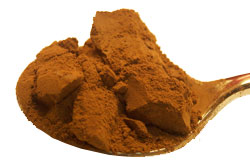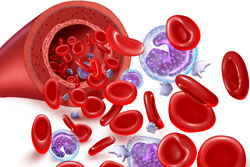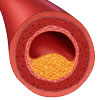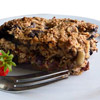- Introduction to chocolate
- History of chocolate
- How is chocolate made?
- Types of chocolate
- Nutritional content of chocolate
- Health risks associated with consuming chocolate
- Dental health and chocolate
- Health benefits of consuming chocolate
- The health benefits without the chocolate
- How much and which chocolate is best consumed?
- Healthy chocolate recipes
Introduction to chocolate
Chocolate is a food typically associated with pleasure and indulgence. It is a sugary food, high in fat and energy, which should be consumed in moderation. Many individuals consume chocolate as a treat or share chocolate at special occasions like birthdays and Christmas. Boxes of chocolates may be given as gifts on special occasions and in Australia it is common to exchange chocolate eggs to celebrate Easter.
There is considerable temptation to also buy chocolate at other times. The confectionary industry in Australia, which monitors chocolate sales, reports that some 70% of confectionary is purchased on impulse and encourage sellers to display confectionary prominently to tempt customers. Australians spend more money on chocolate confectionary products (including chocolate blocks, bars, boxes of chocolates and novelty chocolates like Easter eggs) than on other type of confectionary combined. In 2002, Australians spent $1,550 million on chocolate products (compared to $950 million and $220 million on sugar confectionary and gum).
History of chocolate

Cocoa has been consumed in many cultures for medicinal purposes. The word ‘chocolate’ (derived from the Mayan cacauatol) was coined by Spanish colonisers of South American in the 16th century and since that time chocolate preparation has changed considerably. Cocoa is now usually consumed as sweet beverages or snacks. Mass production of chocolate sweets dates back to the 1800s.
How is chocolate made?
Chocolate is made from cocoa beans which are derived from the cacao tree, a tropical rainforest plant. The cacoa tree is native to Latin America, but is now grown in other tropical areas of the world, mostly to meet the demand for chocolate production. It grows brightly colours pods of seeds, roughly the size of a football. The 30-50 seeds (sometimes called beans) contained within each pod are the key ingredients from which chocolate is made. The seeds are harvested, fermented and dried or roasted to enhance their aroma, before being heated and mixed with other ingredients (e.g. sugar, milk, cocoa butter) to make chocolate. These typically include cocoa or cocoa liquor (non-alcoholic), milk and/or milk solids, sugar and cocoa butter (or vegetable fats).
Types of chocolate

White chocolate contains milk but no cocoa, while dark chocolate contains cocoa (in higher concentrations than milk chocolate) but no milk. Milk chocolate contains both milk and cocoa.
White, milk and dark chocolate can be manufactured in different ways and may therefore take different forms. For example, they may be sold as blocks of plain chocolate, as chocolate bars with additional ingredients such as nuts and wafers or as sauces or drinks.
Another means of classifying chocolate is as either block or compound chocolate. Compound chocolate, most often used for cooking, is made from cocoa and vegetables fats. Block chocolate (white, milk and dark) mixes cocoa with cocoa butter. The distinct compositions of compound compared to block chocolate have an effect on the relative proportions of saturated, mono-unsaturated and poly-unsaturated fat levels in each (see Table 1).
Nutritional content of chocolate
Chocolate contains a variety of ingredients which contain different nutrients and affect the body’s functioning in different ways. Depending on the relative proportions of cocoa, milk and other ingredients, the overall nutritional content of a bar or piece of chocolate varies considerably. For example, chocolate containing greater quantities of milk or milk solids (white or milk chocolate) has a higher calcium content, while chocolate containing greater concentrations of cocoa (dark chocolate) is higher in caffeine. Adding nuts, fruit or other ingredients to chocolate changes its nutritional composition (see Table 1). Chocolate also contains over 400 chemicals including micronutrients which protect the body and its function in various ways. These include Vitamin E, phosphorous, magnesium, iron, copper and plant chemicals.
Cocoa and cocoa butter also contains three types of fat, a monounsaturated fat known as oleic acid, and two saturated fats, stearic acid and palmitic acid. Oliec acid, like other monounsaturated forms of fat including olive oil, does not affect cholesterol levels. There is also evidence that stearic acid, despite being a saturated form of fat has a neutral effect on cholesterol. While palmitic acid (which comprises about one third of chocolate’s fat content) is a saturated fat which is known to affect cholesterol levels, there is no evidence that eating chocolate raises cholesterol levels.
Please note that the values in the table are a general guide and that the nutritional value of a particular brand of chocolate may vary, depending on the relative proportions of cocoa and other ingredients and the manufacturing process used to make the chocolate.
Table 1 – Nutritional composition of chocolate (all per 100g)
 |
Click here to view the table. |
Nutrients derived from cocoa
In terms of the health benefits which may be derived from chocolate consumption (discussed below) the cocoa content is of key importance. Cocoa contains high concentrations of a powerful type of antioxidant known as polyphenols. Flavanoids, the most common subclass of polyphenols, are found in higher concentrations in chocolate than in other flavanoid rich substances (e.g. red wine). A further subclass of flavanoids, flavanols (or flavan-3-ols), are also found in particularly high quantities in cocoa.
Flavanol in chocolate is derived from its cocoa content, and thus the quantity of flavanol varies depending on the amount of cocoa in the chocolate. White chocolate does not contain cocoa and presumably contains no flavanol, while dark chocolate contains more flavanol than milk chocolate. The flavanol content of various types of milk and dark chocolate also varies depending on the quantity of cocoa contained (some types of dark chocolate contains more cocoa than other types), the agricultural environment in which the cocoa was grown and the method used to process the chocolate. Heating of ingredients and other steps in the chocolate production process can reduce the flavanol content by as much as 90%.
The extent to which flavanol from chocolate is absorbed by the body after consumption also varies depending on the type of chocolate. Dark chocolate flavanol is absorbed more readily by the body than milk chocolate flavanol. However, this does not appear to result from the differing milk content of milk and dark chocolate.
 |
For more information on nutrition, including information on types and composition of food, nutrition and people, conditions related to nutrition, and diets and recipes, as well as some useful videos and tools, see Nutrition. |
Health risks associated with consuming chocolate

Dental health
Consumption of chocolate may also increase the risk of dental health problems. Dental caries (cavities) are associated with high sugar intakes, so chocolate products with high concentrations of sugar increase the risk of dental caries. There is also evidence that regular intake of chocolate can cause tooth discolouration.
Health benefits of consuming chocolate
Improved endothelial function and cardiovascular parameters and chocolate
Proposed mechanism

The cardiovascular health benefits of chocolate consumption are related to the activity of the polyphenols (and particularly flavanol) found in the cocoa content of chocolate. Flavanols stimulate nitric oxide secretion and thus consumption of cocoa and flavanol-containing chocolate enhances nitric oxide secretion and widens the arteries. This in turn enhances blood flow and improves a range of cardiovascular parameters. Nitric oxide also has anti-platelet effects (meaning it protects against the formation of blood clots), anti-inflammatory and anti-atheroschlerotic effects (protects against hardening of the walls of the blood vessels).
The anti-oxidant effect of flavanols is also thought to provide cardiovascular protection. Antioxidants are compounds which scavenge and neutralise free radical molecules, or molecules which contain unpaired oxygen atoms. The unpaired oxygen atoms react with and can damage other chemical compounds and cells in the body and also reduce the production of nitric oxide (and thus impair endothelial function). Antioxidants also react with the unpaired oxygen atoms on free radical molecules, and in doing so they neutralise the oxygen atoms and prevent them from damaging the body’s cells. The antioxidant effects of flavanols are thought to underlie the association between chocolate consumption and improved cholesterol. Flavanols assist in the oxidation of low density lipoproteins (LDLs) which are “bad” forms of cholesterol. In doing so, they reduce blood concentrations of LDLs.
Anti-oxidants also counter the nitric oxide suppressing effects of free radical molecules and stimulate nitric oxide secretion. There is also evidence that the flavanols contained in chocolate improve glucose metabolism (and thus reduce insulin sensitivity and other markers of diabetes), by stimulating nitric acid production. Insulin sensitivity is regulated by the availability of nitric oxide concentrations.
Evidence
Endothelial function
There is considerable evidence that cocoa consumption improves endothelial function. One study in which participants consumed either dark chocolate (containing 22g of cocoa) or cocoa-free chocolate daily, reported significantly improved endothelial function (increased arterial blood flow) in the dark chocolate group. Participants who consumed the dark chocolate then tested a cocoa beverage (containing 22g of cocoa). They also experienced improved endothelial function compared to participants who drank a cocoa free beverage. Evidence shows that endothelial function improves after both short-term and long-term consumption of chocolate.
Cardiovascular disease

Studies have also reported a protective effect regarding cardiovascular ill health. One reported that elderly individuals (aged 70-74) who consumed chocolate in the previous year were significantly less likely to have a history of cardiovascular disease compared to those who did not.
Blood pressure
There is also considerable evidence that chocolate consumption can reduce blood pressure. For example, a study of Dutch men reported that those who consumed high quantities of cocoa had lower blood pressure than those with low chocolate consumption. Another compared blood pressure in healthy individuals consuming 100 grams of dark chocolate everyday for 15 days, with blood pressure of subjects consuming 90 grams of white chocolate everyday. It reported significantly lower blood pressure amongst the dark chocolate consumers. Evidence suggests that consuming chocolate can reduce blood pressure as much as some medications used to reduce blood pressure, and chocolate consumption could reduce the risk of stroke and cardiovascular disease by 20% and 10% respectively.
Inflammatory markers
There is also some evidence that cocoa consumption reduces inflammation which contributes to vascular ill-health. For example, one study showed consumption of dark chocolate was inversely associated with c-reactive protein levels. High levels of c-reactive protein are a marker of inflammation and an indicator of coronary heart disease. However, the study found that the relationship was only present when chocolate was consumed in moderation (~20 grams of dark chocolate every three days). The association disappeared when greater quantities of dark chocolate were consumed. The authors of this study concluded that moderate consumption of dark chocolate could reduce the risk of coronary events in men by 26% and in women by 33%.
Platelet activity

Diabetes
Evidence also suggests that chocolate consumption can improve insulin sensitivity and reduce the risk of diabetes. A Norwegian study reported a significantly lower prevalence of diabetes amongst elderly subjects (70-74) who consumed chocolate in the previous year compared to those who did not. A study of healthy individuals (average age 34 years) reported improved insulin sensitivity in subjects who consumed polyphenol-rich dark chocolate compared to those who consumed polyphenol-free white chocolate. Insulin sensitivity improved after just 15 days of consuming 100 grams of dark chocolate per day.
Improved cholesterol
Studies have also shown that consumption of dark chocolate improves cholesterol. One study, in which healthy individuals consumed either a flavanol-enriched dark chocolate bar or a dark chocolate bar with no added flavanols, reported significant reductions in total cholesterol and LDLs (bad cholesterol) amongst flavanol-enriched chocolate consumers. As high cholesterol is a significant risk factor for heart disease, dark chocolate consumption therefore also indirectly reduces the risk of cardiovascular disease, by improving cholesterol.
 |
For more information on cholesterol, including the health effects of high cholesterol and ways to lower cholesterol levels, as well as some useful tools, see Cholesterol. |
Cancer and chocolate
Proposed mechanism
The anti-oxidant properties of cocoa are thought to protect against cancer by protecting cells from oxidative damage which contributes to the growth of cancerous cells. Flavanoids in cocoa appear to interrupt the cell cycle of cancerous cells (the process through which cancerous cells replicate themselves and grow excessively to form tumours). Effectively, they impair the growth of cancerous tumours, however the way in which flavanoids exert this effect is not yet well understood.
Evidence
Evidence regarding the effect of chocolate or flavanoid consumption on cancer risk is somewhat contradictory. While test tube/laboratory studies have shown that cocoa-derived flavanoids interrupt the replication of cancer cells, there is no evidence from studies of cocoa consumption and incidence of cancer amongst humans to indicate whether or not flavanoids exert the same effect in the human body.
 |
For more information on cancer, including breast, prostate, kidney and stomach cancer, see Cancer: Overview. |
Cognitive performance and chocolate
Proposed mechanism

Evidence
Evidence suggests that elderly individuals who consume chocolate have better cognitive function than those who do not. A study of Norwegian 70-74 year olds reported that chocolate intake in the past year was associated with better performance on numerous cognitive tests. The best cognitive performance was achieved with consumption of 10 grams of chocolate per day.
Photoprotection (protection from light) and chocolate
Proposed mechanism
Photoprotection refers to protection from light. In the human body, the skin provides photoprotection by absorbing the sun’s rays. This results in the production of free radical molecules (molecules with unpaired oxygen atoms which can break away and damage or alter other molecules and cells in the body). Free radical molecules can cause damage to skin cells and result in the growth of cancerous cells.
The properties of skin vary between individuals according to their genes (e.g. pigmentation of their skin) and the extent to which the skin is exposed to sunlight (e.g. use of sunscreen or a hat), and these factors influence the extent to which the skin is photoprotective. Nutritional intake is one factor affecting skin photoprotection and dietary antioxidants (including flavanols in cocoa) are thought to exert a photoprotective effect. The proposed mechanism by which they exert this effect is by reducing the sensitivity of skin cells to UV exposure.
Evidence
One study which compared the effect of UV-exposure on the skin of women who had consumed high and low flavanol cocoa drinks daily prior to UV exposure, reported increased photoprotection (reduced sunburn) and improved skin condition (greater blood flow to skin, increased skin density and hydration) amongst women who consumed the high flavanol cocoa drink.
General health and wellbeing and chocolate

Sexual health and chocolate
Chocolate has also been proposed to have an aphrodisiac effect (increase sexual desire) because it stimulates the release of serotonin (a mood regulating hormone which also regulates blood flow) and phenylethylamine (a stimulant which regulates mood). However, there is currently limited scientific evidence to support this theory.
Chocolate may also enhance sexual response in men and women (e.g. improve erectile function and vaginal lubrication) because chocolate consumption stimulates the release of nitric oxide which plays an important role in regulating sexual function. As mentioned above, nitric oxide regulates blow flow through the arteries, and the more nitric oxide released, the more blood that flows through the arteries. As erectile function depends on increased blood flow to the penis, the availability of nitric oxide can affect a man’s ability to get an erection. Nitric oxide also plays a role in regulating the movement of smooth muscles, that is, muscles which expand and contract involuntarily. Smooth muscles in the genitals of men and women are involved in genital arousal and orgasm, and thus chocolate may also affect an individual’s genital arousal and orgasmic ability. However, research studies are yet to be undertaken investigating the effect of eating chocolate on sexual response.
The health benefits without the chocolate

There is a risk of weight gain (and associated cardiovascular ill-health which accompanies weight gain) from increasing chocolate consumption and so chocolate should be consumed with caution.
How much and which chocolate is best consumed?
Chocolate is an energy rich food which is high in fat and sugar and the National Health and Medical Research Council recommend that such foods are consumed in moderation.
People who enjoy consuming chocolate will benefit most from dark varieties of chocolate which have cocoa or cocoa liquor listed first (and before sugar) in the ingredients. Chocolate should be consumed in small quantities (e.g. 10-15 grams per day). It is also important to bear in mind that over consumption of chocolate is likely to lead to weight gain and obesity, due to its high energy content. Individuals who wish to consume chocolate may need to reduce their calorie intake from other components of their diet, or increase their physical activity to offset the energy gained from consuming chocolate.
Healthy chocolate recipes
 |
A quick and easy low-fat slice packed with dates, walnuts and chocolate. For more information, see Chocolate Date Slice. |
 |
Enjoy a healthy, easy to make chocolate sultana cake. For more information, see Chocolate Sultana Cake. |
 |
Indulge in a deliciously low-fat dark chocolate brownie. Serve warm from the oven with fresh berries for a great dessert. For more information, see Dark Chocolate Brownies. |
 |
A quick and easy low-fat oat slice packed with dried fruits, nuts and chocolate. For more information, see Fruit and Nut Chocolate Slice. |
References
- Chocolate [online]. Deakin, ACT: Dietitians Association of Australia; 2008 [cited 19 March 2010]. Available from: URL link
- Australian Confectionery Industry Profile [online]. Camberwell, VIC: Confectionery Manufacturers of Australasia; 2004 [cited 2010, March 1] Available from: URL link
- Hachiya I. Discourse on a history of chocolate: Culture and science (Part 1). Foods Food Ingredients J Jpn. 2003;208(3):217-33. [Full text]
- Vlachopoulos C, Alexopoulos N, Stefanadis C. Effect of dark chocolate on arterial function in healthy individuals: Cocoa instead of ambrosia? Curr Hypertens Rep. 2006;8(3):205-11. [Abstract]
- Chocolate [online]. Chicago, IL: Field Museum; 2007 [cited 20 March 2010]. Available from: URL link
- Keen CL, Holt RR, Oteiza P, et al. Cocoa antioxidants and cardiovascular health. Am J Clin Nutr. 2005;81(1 Suppl): 298s-303s. [Abstract | Full text]
- Australian food, supplement and nutrient database (AUSNUT) 2007 [online]. Barton, ACT: Food Standards Australia New Zealand; July 2008 [cited 11 November 2009]. Available from: URL link
- Chocolate and your health: Guilty pleasure or terrific treat? HEALTHBeat [online]. Boston, MA: Harvard Medical School; 3 March 2009 [cited 19 March 2010]. Available from: URL link
- Ding EL, Hutfless SM, Ding X, Girotra S. Chocolate and prevention of cardiovascular disease: A systematic review. Nutr Metab. 2006;3:2. [Abstract | Full text]
- Nurk E, Refsum H, Drevon CA, et al. Intake of flavonoid-rich wine, tea, and chocolate by elderly men and women is associated with better cognitive test performance. J Nutr. 2009;139(1):120-7. [Abstract | Full text]
- Heiss C, Dejam A, Kleinbongard P, et al. Vascular effect of cocoa rich in flavan-3-ols. JAMA. 2003;290(8):1030-1. [Abstract | Full text]
- Smith RN, Mann NJ, Braue A, et al. A low-glycemic-load diet improves symptoms in acne vulgaris patients: A randomized controlled trial. Am J Clin Nutr. 2007;86(1):107-15. [Abstract | Full text]
- Corti R, Flammer AJ, Hollenberg NK, Lüscher TF. Cocoa and cardiovascular health. Circulation. 2009;119(10):1433-41. [Abstract | Full text]
- Plotino G, Buono L, Grande NM, et al. Nonvital tooth bleaching: A review of the literature and clinical procedures. J Endod. 2008;34(4):394-407. [Abstract]
- Faridi Z, Njike VY, Dutta S, et al. Acute dark chocolate and cocoa ingestion and endothelial function: A randomized controlled crossover trial. Am J Clin Nutr. 2008;88(1):58-63. [Abstract | Full text]
- Sies H, Schewe T, Heiss C, Kelm M. Cocoa polyphenols and inflammatory mediators. Am J Clin Nutr. 2005;81(1 Suppl):304S-312S. [Abstract | Full text]
- Traish A, Kim N. The physiological role of androgens in penile erection: regulation of corpus cavernosum structure and function. J Sex Med. 2005;2(6):759-70. [Abstract]
- Traish AM, Kim N, Min K, et al. Role of androgens in female genital sexual arousal: Receptor expression, structure, and function. Fertil Steril. 2004;77(Suppl 4):S11-19. [Abstract | Full text]
- Grassi D, Lippi C, Necozione S, et al. Short-term administration of dark chocolate is followed by a significant increase in insulin sensitivity and a decrease in blood pressure in healthy persons. Am J Clin Nutr. 2005;81(3):611-4. [Abstract | Full text]
- Hooper L, Kroon PA, Rimm EB, et al. Flavonoids, flavonoid-rich foods, and cardiovascular risk: A meta-analysis of randomized controlled trials. Am J Clin Nutr. 2008;88(1):38-50. [Abstract | Full text]
- Buijsse B, Feskens EJ, Kok FJ, Kromhout D. Cocoa intake, blood pressure, and cardiovascular mortality: The Zutphen Elderly Study. Arch Intern Med. 2006;166(4):411-7. [Abstract | Full text]
- Janszky I, Mukamal KJ, Ljung R, et al. Chocolate consumption and mortality following a first acute myocardial infarction: The Stockholm Heart Epidemiology Program. J Intern Med. 2009;266(3):248-57. [Abstract]
- Taubert D, Roesen R, Schömig E. Effect of cocoa and tea intake on blood pressure: A meta-analysis. Arch Intern Med. 2007;167(7):626-34. [Abstract | Full text]
- Grassi D, Necozione S, Lippi C, et al. Cocoa reduces blood pressure and insulin resistance and improves endothelium-dependent vasodilation in hypertensives. Hypertension. 2005;46(2):398-405. [Abstract | Full text]
- di Giuseppe R, Di Castelnuovo A, Centritto F, et al. Regular consumption of dark chocolate is associated with low serum concentrations of C-reactive protein in a healthy Italian population. J Nutr. 2008;138(10):1939-45. [Abstract | Full text]
- Allen RR, Carson L, Kwik-Uribe C, et al. Daily consumption of a dark chocolate containing flavanols and added sterol esters affects cardiovascular risk factors in a normotensive population with elevated cholesterol. J Nutr. 2008;138(4):725-31. [Abstract | Full text]
- Ramljak D, Romanczyk LJ, Metheny-Barlow LJ, et al. Pentameric procyanidin from Theobroma cacao selectively inhibits growth of human breast cancer cells. Mol Cancer Ther. 2005;4(4):537-46. [Abstract | Full text]
- Hertog MG, Kromhout D, Aravanis C, et al. Flavonoid intake and long-term risk of coronary heart disease and cancer in the seven countries study. Arch Intern Med. 1995;155(4):381-6. [Abstract]
- Heinrich U, Neukam K, Tronnier H, et al. Long-term ingestion of high flavanol cocoa provides photoprotection against UV-induced erythema and improves skin condition in women. J Nutr. 2006;136(6):1565-9. [Abstract | Full text]
- Strandberg TE, Strandberg AY, Pitkälä K, et al. Chocolate, well-being and health among elderly men. Eur J Clin Nutr. 2008;62(2):247-53. [Abstract]
- Afoakwa E. Cocoa and chocolate consumption: Are there aphrodisiac and other beneficial implications on human health? South Afr J Clin Nutr. 2008;21(3):107-13. [Abstract | Full text]
- Dietary guidelines for Australian adults [online]. Canberra, ACT: National Health and Medical Research Council; 10 April2003 [cited 3 March 2010]. Available from: URL link
All content and media on the HealthEngine Blog is created and published online for informational purposes only. It is not intended to be a substitute for professional medical advice and should not be relied on as health or personal advice. Always seek the guidance of your doctor or other qualified health professional with any questions you may have regarding your health or a medical condition. Never disregard the advice of a medical professional, or delay in seeking it because of something you have read on this Website. If you think you may have a medical emergency, call your doctor, go to the nearest hospital emergency department, or call the emergency services immediately.







